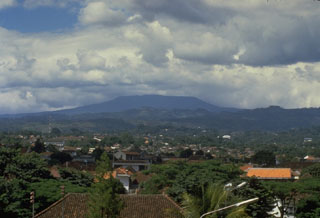Report on Tangkuban Parahu (Indonesia) — 8 February-14 February 2023
Smithsonian Institution / US Geological Survey
Weekly Volcanic Activity Report, 8 February-14 February 2023
Managing Editor: Sally Sennert.
Please cite this report as:
Global Volcanism Program, 2023. Report on Tangkuban Parahu (Indonesia) (Sennert, S, ed.). Weekly Volcanic Activity Report, 8 February-14 February 2023. Smithsonian Institution and US Geological Survey.
Tangkuban Parahu
Indonesia
6.77°S, 107.6°E; summit elev. 2084 m
All times are local (unless otherwise noted)
PVMBG issued a special report based on recent observations of Tangkuban Parahu. Webcam images captured from 1830 on 9 February to 0300 on 10 February showed incandescence emanating from Ecoma Crater. A team of PVMBG scientists inspected the crater during 1900-2000 on 10 February to identify the source of the incandescence. They observed intense emissions rising from Ecoma Crater, heard roaring and rumbling, and detected a strong sulfur odor, but did not see incandescence. Remote measurements of solfatara temperatures in Ecoma Crater using thermal cameras show varying temperatures, with a maximum of 105 degrees Celsius, and were influenced by airflow conditions at the crater. A multi-gas detector did not record high concentrations of volcanic gases. Seismic data from June 2022 to February 2023 suggested variable rates of fluid movement and increased heating of the subsurface to the surface. Data from monitoring instruments and visual observations indicated that the incandescent was not caused by rising magma and instead by reactions of sulfur deposits around the vents; the Alert Level remained at 1 (on a scale of 1-4) and tourists were advised to avoid descending into the craters.
Geological Summary. Gunung Tangkuban Parahu is a broad stratovolcano overlooking Indonesia's former capital city of Bandung. The volcano was constructed within the 6 x 8 km Pleistocene Sunda caldera, which formed about 190,000 years ago. The volcano's low profile is the subject of legends referring to the mountain of the "upturned boat." The Sunda caldera rim forms a prominent ridge on the western side; elsewhere the rim is largely buried by deposits of the current volcano. The dominantly small phreatic eruptions recorded since the 19th century have originated from several nested craters within an elliptical 1 x 1.5 km summit depression.
Source: Pusat Vulkanologi dan Mitigasi Bencana Geologi (PVMBG, also known as CVGHM)

